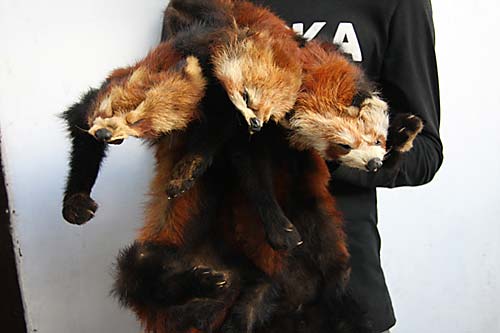The Metropolitan Police Crime Division arrested four persons with nine red panda skins from Kapan, Kathmandu last week. It was the single biggest seizure of body parts of endangered wild animal.
According to statistics of the Metropolitan Police Office, the law enforcement agency has confiscated as many as 70 units of red panda hide, while District Forest Office, Kathmandu brought to book 180 poachers and wildlife criminals in the Kathmandu Valley in the past four years.
The concerned district Forest office is the only authorised agency to prosecute wildlife poachers and smugglers under the National Parks and Wildlife Conservation Act, 1973. Any suspect arrested by police in connection with wildlife crimes is handed over to the DFO.
Police officials said cases of poaching red pandas, and sale, possession and smuggling of their skin are on the rise. 44 red panda hides were seized in the last two years alone, a testimony to the increased threat to red pandas.
Red panda, called ‘habre’ in Nepali, is an endangered animal whereas trade and smuggling of its body parts is illegal under the prevailing laws, as well as the Convention on International Trade in Endangered Species of Wild Fauna and Flora (CITES Convention, 1975). The act has a clear provision of complete protection of protected wildlife, including red panda under its Section 10. As per section 26 (2) of the act, any person who kills or tries to kill red panda may be fined up to Rs 40,000-75,000 or jailed for 1-10 years, or both.
According to the Department of National Parks and Wildlife Conservation, Nepal is home to around two per cent of the global population of red panda amounting approximately to 300 individuals. Their numbers are dwindling due to all-pervasive human pressure on their natural habitat and poaching.
A study by Red Panda Network Nepal shows that the wild animals are found in Panchthar, Taplejung, Shankhuwasabha, Solukhumbhu, Ramechhap, Ilam, Dolakha, Sindhupalchowk, Rasuwa and Khotang districts. They live at altitudes of between 2,200 and 4,800 metres.
Police said red panda hides and body parts are usually smuggled to China and Myanmar for their supposed medicinal qualities and aesthetic use. Poachers have been found selling red panda hide for Rs 200,000-6,00,000 depending on their clients.
(c) The Himalayan Times


